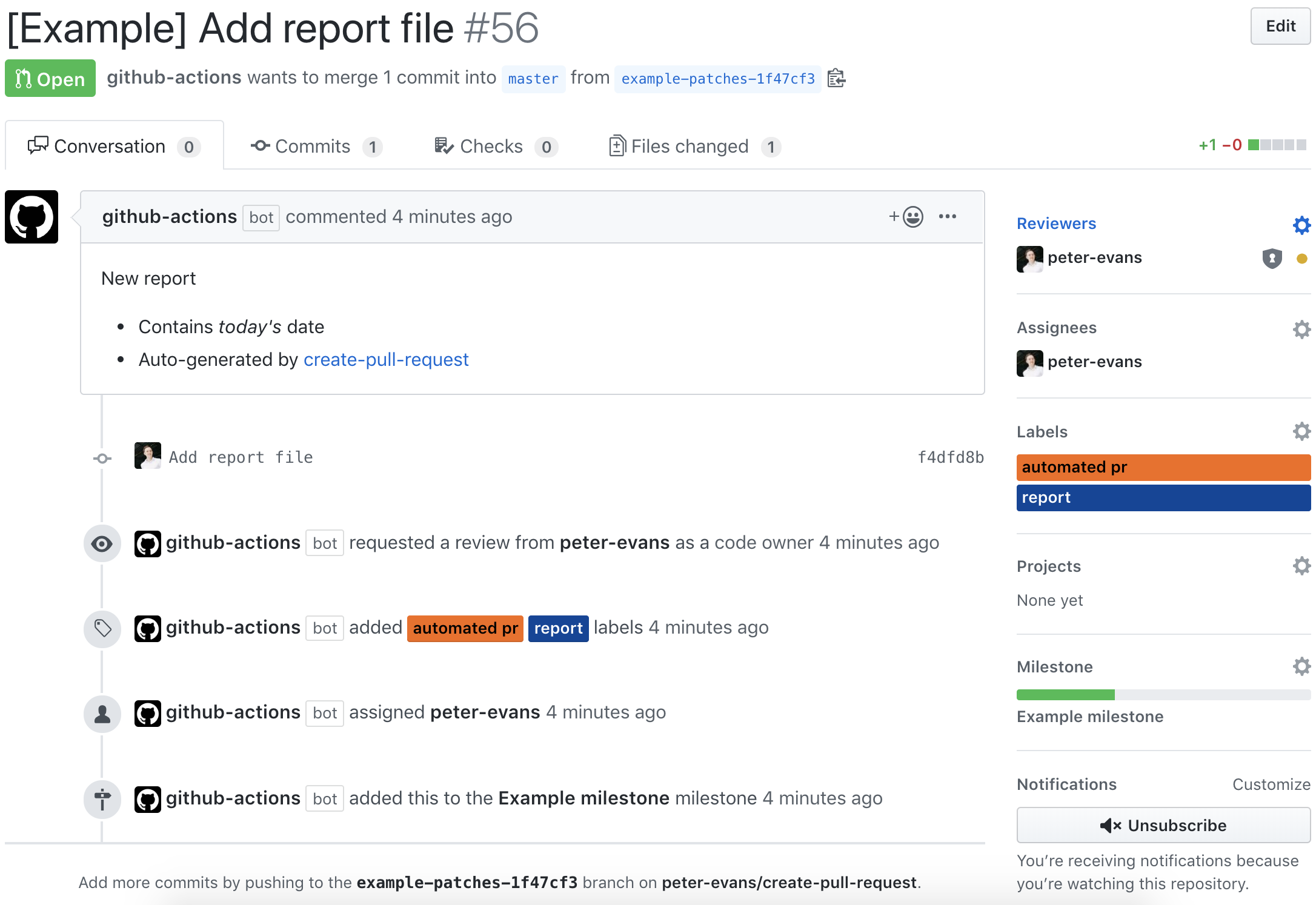Pin dependency @zeit/ncc to 0.20.5
 Create Pull Request
Create Pull Request
A GitHub action to create a pull request for changes to your repository in the actions workspace.
Changes to a repository in the Actions workspace persist between steps in a workflow. This action is designed to be used in conjunction with other steps that modify or add files to your repository. The changes will be automatically committed to a new branch and a pull request created.
Create Pull Request action will:
- Check for repository changes in the Actions workspace. This includes untracked (new) files as well as modified files.
- Commit all changes to a new branch, or update an existing pull request branch.
- Create a pull request to merge the new branch into the currently active branch executing the workflow.
Usage
See examples for detailed use cases.
- name: Create Pull Request
uses: peter-evans/create-pull-request@v1.7.0
with:
token: ${{ secrets.GITHUB_TOKEN }}
Note: If you want pull requests created by this action to trigger an on: pull_request workflow then you must use a Personal Access Token instead of the default GITHUB_TOKEN.
See this issue for further details.
Action inputs
These inputs are all optional. If not set, sensible default values will be used.
| Name | Description | Default |
|---|---|---|
commit-message |
The message to use when committing changes. | Auto-committed changes by create-pull-request action |
author-email |
The email address of the commit author. | For push events, the HEAD commit author. Otherwise, <GITHUB_ACTOR>@users.noreply.github.com, where GITHUB_ACTOR is the GitHub user that initiated the event. |
author-name |
The name of the commit author. | For push events, the HEAD commit author. Otherwise, <GITHUB_ACTOR>, the GitHub user that initiated the event. |
title |
The title of the pull request. | Auto-generated by create-pull-request action |
body |
The body of the pull request. | Auto-generated pull request by [create-pull-request](https://github.com/peter-evans/create-pull-request) GitHub Action |
labels |
A comma separated list of labels. | none |
assignees |
A comma separated list of assignees (GitHub usernames). | none |
reviewers |
A comma separated list of reviewers (GitHub usernames) to request a review from. | none |
team-reviewers |
A comma separated list of GitHub teams to request a review from. | none |
milestone |
The number of the milestone to associate this pull request with. | none |
branch |
The branch name. See Branch naming below for details. | create-pull-request/patch |
base |
Overrides the base branch. Use with caution! | Defaults to the currently checked out branch. |
branch-suffix |
The branch suffix type. Valid values are short-commit-hash, timestamp, random and none. See Branch naming below for details. |
short-commit-hash |
Outputs
The pull request number is output as both an environment variable and a step output. Note that in order to read the step output the action step must have an id.
- name: Create Pull Request
id: cpr
uses: peter-evans/create-pull-request@v1.7.0
with:
token: ${{ secrets.GITHUB_TOKEN }}
- name: Check outputs
run: |
echo "Pull Request Number - ${{ env.PULL_REQUEST_NUMBER }}"
echo "Pull Request Number - ${{ steps.cpr.outputs.pr_number }}"
Branch naming
For branch naming there are two strategies. Always create a new branch each time there are changes to be committed, OR, create a fixed-name pull request branch that will be updated with any new commits until it is merged or closed.
Strategy A - Always create a new pull request branch (default)
For this strategy there are three options to suffix the branch name.
The branch name is defined by the input branch and defaults to create-pull-request/patch. The following options are values for branch-suffix.
-
short-commit-hash(default) - Commits will be made to a branch suffixed with the short SHA1 commit hash. e.g.create-pull-request/patch-fcdfb59,create-pull-request/patch-394710b -
timestamp- Commits will be made to a branch suffixed by a timestamp. e.g.create-pull-request/patch-1569322532,create-pull-request/patch-1569322552 -
random- Commits will be made to a branch suffixed with a random alpha-numeric string. This option should be used if multiple pull requests will be created during the execution of a workflow. e.g.create-pull-request/patch-6qj97jr,create-pull-request/patch-5jrjhvd
Strategy B - Create and update a pull request branch
To use this strategy, set branch-suffix to the value none. The input branch defaults to create-pull-request/patch. Commits will be made to this branch and a pull request created. Any subsequent changes will be committed to the same branch and reflected in the existing pull request.
Ignoring files
If there are files or directories you want to ignore you can simply add them to a .gitignore file at the root of your repository. The action will respect this file.
Reference Example
The following workflow is a reference example that sets all the main inputs.
See examples for more realistic use cases.
name: Create Pull Request
on: push
jobs:
createPullRequest:
runs-on: ubuntu-latest
steps:
- uses: actions/checkout@v1
- name: Create report file
run: date +%s > report.txt
- name: Create Pull Request
id: cpr
uses: peter-evans/create-pull-request@v1.7.0
with:
token: ${{ secrets.GITHUB_TOKEN }}
commit-message: Add report file
author-email: peter-evans@users.noreply.github.com
author-name: Peter Evans
title: '[Example] Add report file'
body: |
New report
- Contains *today's* date
- Auto-generated by [create-pull-request][1]
[1]: https://github.com/peter-evans/create-pull-request
labels: report, automated pr
assignees: peter-evans
reviewers: peter-evans
milestone: 1
branch: example-patches
branch-suffix: short-commit-hash
- name: Check outputs
run: |
echo "Pull Request Number - ${{ env.PULL_REQUEST_NUMBER }}"
echo "Pull Request Number - ${{ steps.cpr.outputs.pr_number }}"
This reference configuration will create pull requests that look like this:

